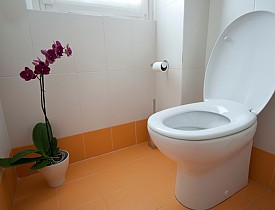Maintaining an Aerobic Septic System

An aerobic septic system is one of several choices when you're deciding on a septic system for your home. The benefits of installing an aerobic septic system are high efficiency, a nearly indefinite lifespan, and possibly less land needed for your leaching system.
What is Different about an Aerobic Septic System?
Oxygen -- lots of it. Oxygen is the key to a healthy septic system. High oxygen content equals greater production of bacteria that will decompose waste. Aerobic septic systems require electricity and a somewhat higher level of maintenance. They are also two to three times more expensive than most other systems. However, an aerobic septic system will break down effluvia far more quickly and pose less potential for environmental problems.
Maintain an Aerobic Septic System
- Don't overload the system. For example, spread out your loads of laundry. Repair leaking faucets and toilets.
- Use biodegradable or septic-safe products, especially toilet paper.
- Do not throw grease, cigarette butts, food scraps, oil, tampons, diapers or sanitary pads down the toilet or sink.
- Keep your system alkaline (good bacteria die in acid conditions) with alternative cleaning agents like borax and baking soda.
- Use disinfection tablets as recommended by the manufacturer.
- Check the pump once a month.
- Hire a pro to inspect your septic system annually.
- Have your tank pumped every two to three years, depending on use. When the tank is pumped, make sure neither of the baffles is damaged.
- Check occasionally for insect damage, especially in warmer climates. Insects can harm electrical elements of the system, such as breaker boxes.
- Keep careful and detailed maintenance records, together with a sketch showing exactly where your septic tank is located.
Other Common Septic Systems
Other types of septic systems tend not to last as long, averaging 20 to 25 years. These systems include:
- Cement, which can easily crack.
- Steel, the least desirable choice due to short lifespan and susceptibility to rust.
- Plastic or fiberglass: a good second choice to an aerobic septic system, as it won't rust and is unlikely to crack.
Keep Your Non-Aerobic System Aerobic
Have your soil analyzed. A soil scientist will be able to recommend the best place for your leaching system, the primary place that oxygen is introduced to the effluvia. Gray water leaches out of the system and sludge is left behind. Septic sludge generally decomposes very slowly due to low oxygen content and low temperatures. Leaching systems are placed relatively close to the surface of sub soils to draw in the most oxygen. Pathogens and viruses pass into sub soils to be "treated" by still other forms of bacteria.
Remember, the key to a healthy septic system is oxygen and bacteria.
Updated March 18, 2018.
Looking for a Pro? Call us (866) 441-6648

Plumbing Average Costs
Plumbers Experiences

Do Your Homework Before You Have A New Water Heater Installed

A Modern, Nice-looking Bathroom Remodel Also Adds Value To Our Home



